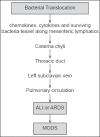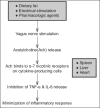Gut failure in critical care: old school versus new school
- PMID: 26130136
- PMCID: PMC4480167
Gut failure in critical care: old school versus new school
Abstract
The concept of bacterial translocation and gut-origin sepsis as causes of systemic infectious complications and multiple organ deficiency syndrome in surgical and critically ill patients has been a recurring issue over the last decades attracting the scientific interest. Although gastrointestinal dysfunction seemingly arises frequently in intensive care unit patients, it is usually underdiagnosed or underestimated, because the pathophysiology involved is incompletely understood and its exact clinical relevance still remains controversial with an unknown yet probably adverse impact on the patients' outcome. The purpose of this review is to define gut-origin sepsis and related terms, to describe the mechanisms leading to gut-derived complications, and to illustrate the therapeutic options to prevent or limit these untoward processes.
Keywords: Gut failure; bacterial translocation; immunonutrition; selective gut decontamination.
Conflict of interest statement
Conflict of Interest: None
Figures





References
-
- Deitch EA. Bacterial translocation or lymphatic drainage of toxic products from the gut: what is important in human beings? Surgery. 2002;131:241–244. - PubMed
-
- Reintam A, Kern H, Starkopf J. Defining gastrointestinal failure. Acta Clin Belg Suppl. 2007;1:168–172. - PubMed
-
- Gatt M, Reddy BS, MacFie J. Review article: bacterial translocation in the critically ill - evidence and methods of prevention. Aliment Pharmacol Ther. 2007;25:741–757. - PubMed
-
- Louis K, Netea MG, Carrer DP, et al. Bacterial translocation in an experimental model of multiple organ dysfunctions. J Surg Res. 2013;183:686–694. - PubMed
Publication types
LinkOut - more resources
Full Text Sources
